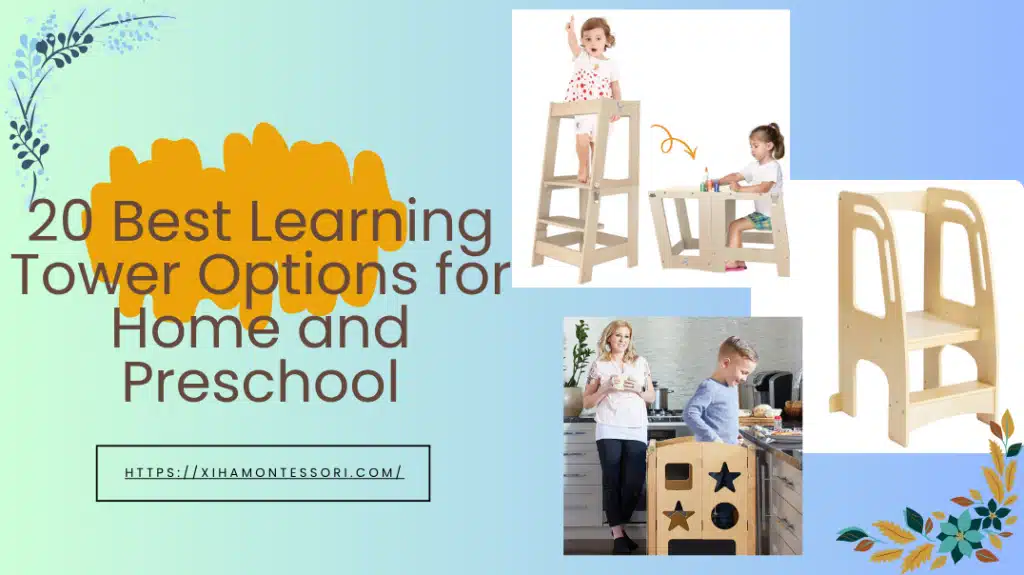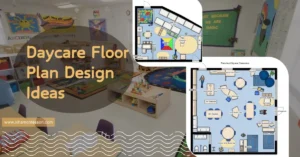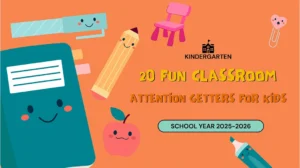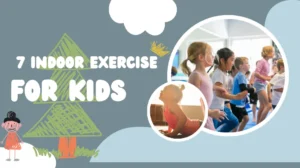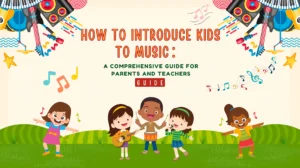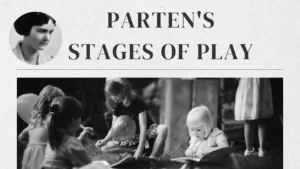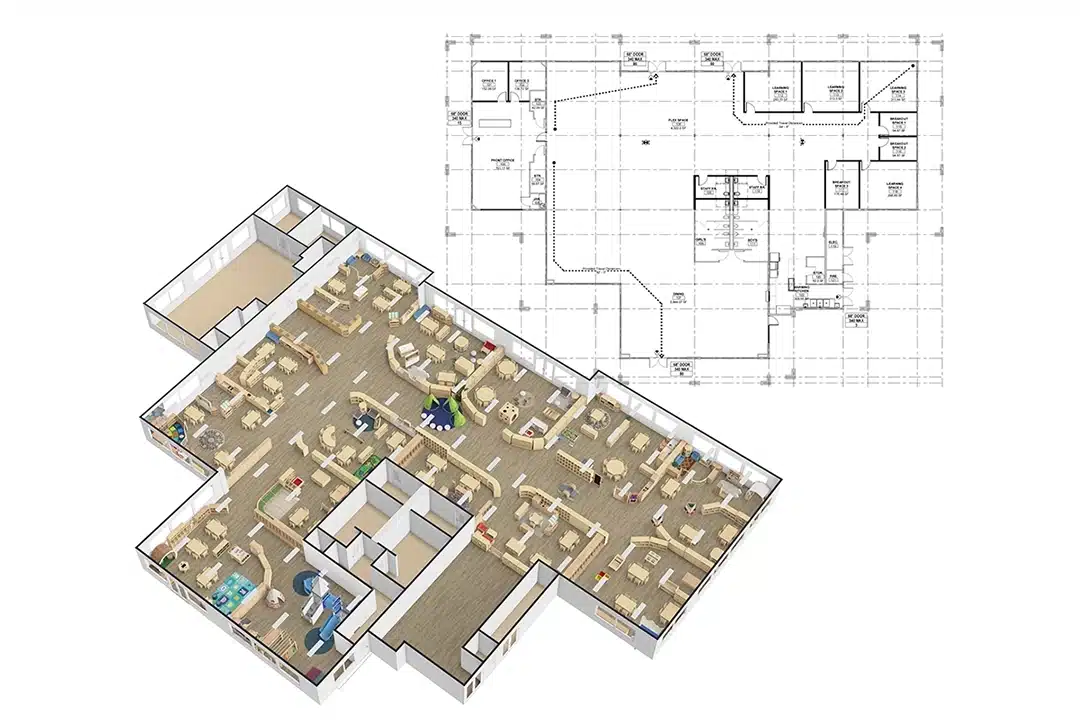Are you searching for the Best Learning Tower but feeling overwhelmed by too many choices? Are you unsure which design is safest for toddlers to use independently? Do you wonder what features matter most for long-term use in a preschool or home kitchen? Can a learning tower truly support your child’s development?
The Best Learning Tower isn’t just a piece of furniture—it’s a developmental tool that encourages independence, strengthens motor skills, and builds confidence in young children. Whether used in a home kitchen or a preschool classroom, it gives toddlers safe access to countertops, sinks, and activity tables. With the right learning tower, kids learn to help with cooking, cleaning, and even handwashing, all while developing spatial awareness, coordination, and responsibility.
Choosing the right tower means balancing safety, function, and design. In this guide, I’ll break down 20 of the Best Learning Tower options for both home and preschool use, so you can invest in a product that truly supports early childhood education.
What is the learning tower?
A learning tower is more than just a piece of furniture—it’s an educational tool designed to empower young children by allowing them to participate in everyday activities at adult height. Often referred to as a Montessori learning tower, it’s essentially a safety stool with guardrails that lifts toddlers to counter or table level, providing them a secure platform to engage in real-world tasks. It bridges the gap between the child’s natural desire to help and the adult environment, giving them a safer, more stable way to stand independently beside a caregiver.
The concept originates from Montessori principles, which emphasize independence, hands-on learning, and physical involvement in daily life. The learning tower aligns perfectly with this, offering young children, typically between 18 months and 6 years old, the opportunity to observe, imitate, and participate. It gives them access to kitchen counters for mixing ingredients, brushing teeth at a sink, or even painting on a table, while being safely enclosed on all sides.
To summarize, the learning tower is not merely a step stool—it’s an invitation. An invitation for the child to join the adult world, to participate, to contribute, and to grow. Whether you are a parent at home or a kindergarten owner sourcing educational furniture, understanding the true role and value of the learning tower is the first step to making the right choice.
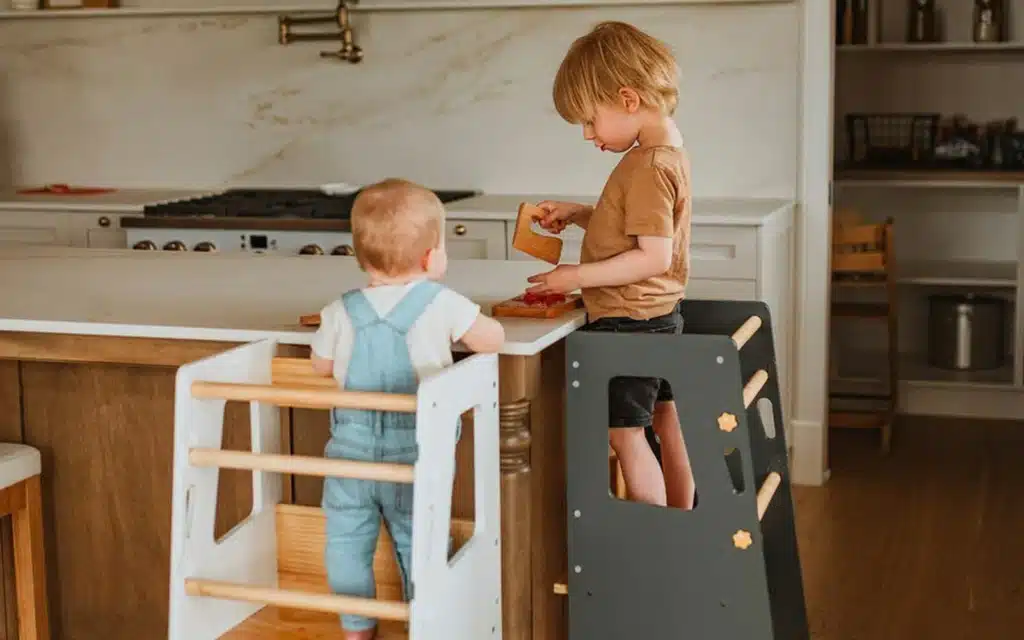
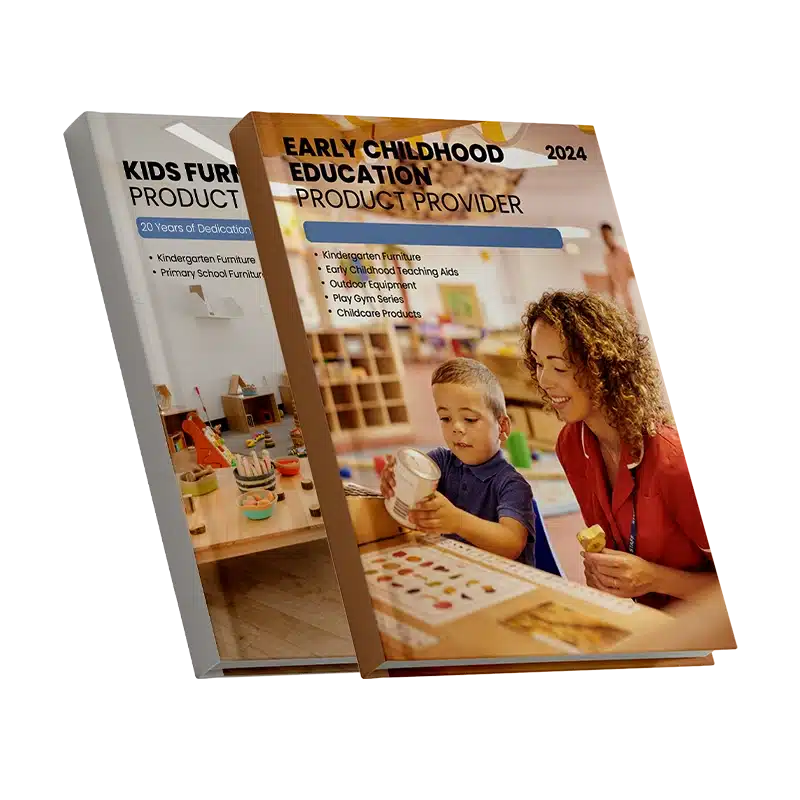
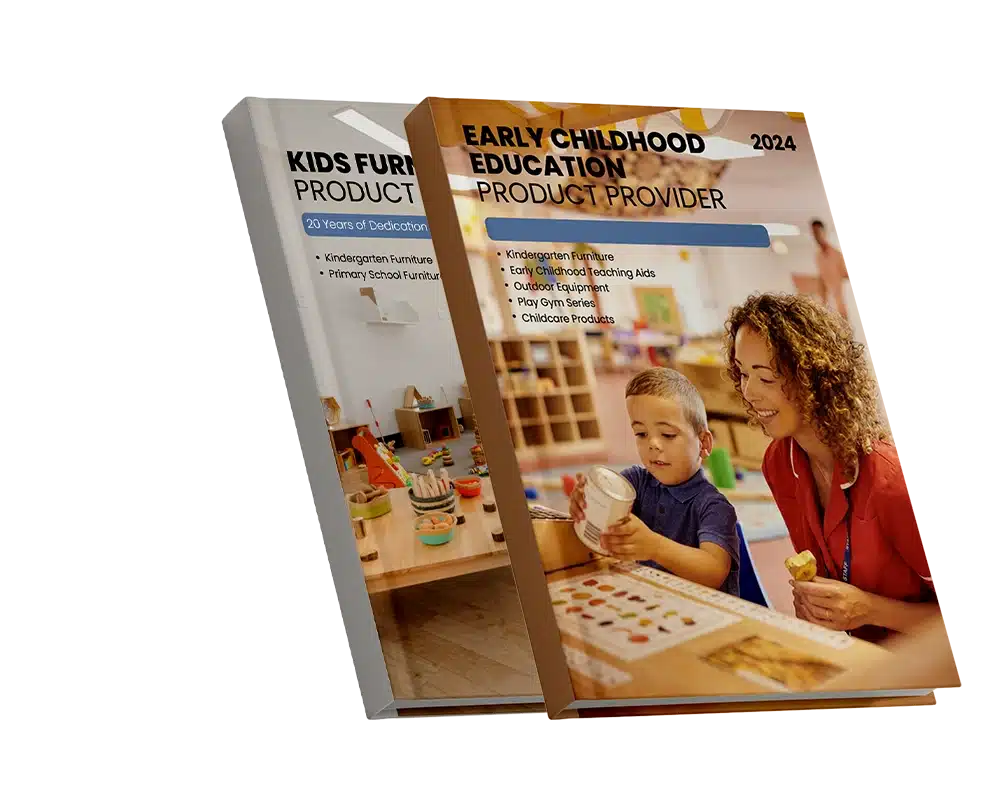
Developmental Benefits of Learning Towers
Learning towers are not only practical furniture for toddlers—they are deeply rooted in early childhood developmental theory. Built on principles from Montessori and Reggio Emilia approaches, a well-designed learning tower supports children across multiple developmental domains, including physical, cognitive, emotional, and social growth.
Physical Development
Gross Motor Skills
Standing on a stable platform encourages toddlers to use their legs, core, and arms in a coordinated way. As they climb in and out of the tower, they engage muscles that are critical for balance and posture. The act of reaching, turning, and stretching while standing at adult height enhances their spatial awareness and body control. Over time, regular use of the toddler tower can improve overall coordination and body confidence.
Fine Motor Development
While on the learning tower, children often engage in hands-on activities such as stirring, pouring, sorting, or cutting soft foods under supervision. These repetitive tasks help refine their hand-eye coordination and dexterity. Fine motor skills are foundational for future academic tasks like writing, drawing, and using scissors.
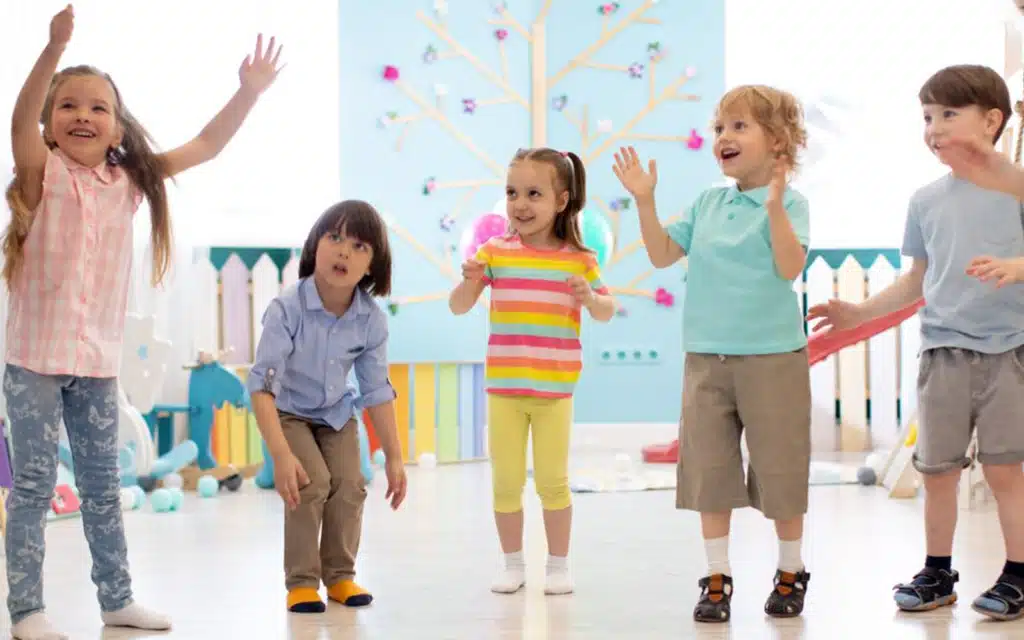
Cognitive Development
Problem Solving and Critical Thinking
When toddlers stand at counter level, they are not passive observers—they become active participants. They watch how adults complete complex tasks and begin to understand sequences and patterns. For example, helping to prepare a sandwich involves identifying ingredients, placing them in the correct order, and learning basic kitchen routines.
Executive Function Skills
Learning towers create opportunities for children to practice focus, memory, and impulse control. When a child follows directions to mix a batter or place toys into specific containers, they are practicing working memory and task management. This lays the foundation for future learning in both academic and real-world settings.
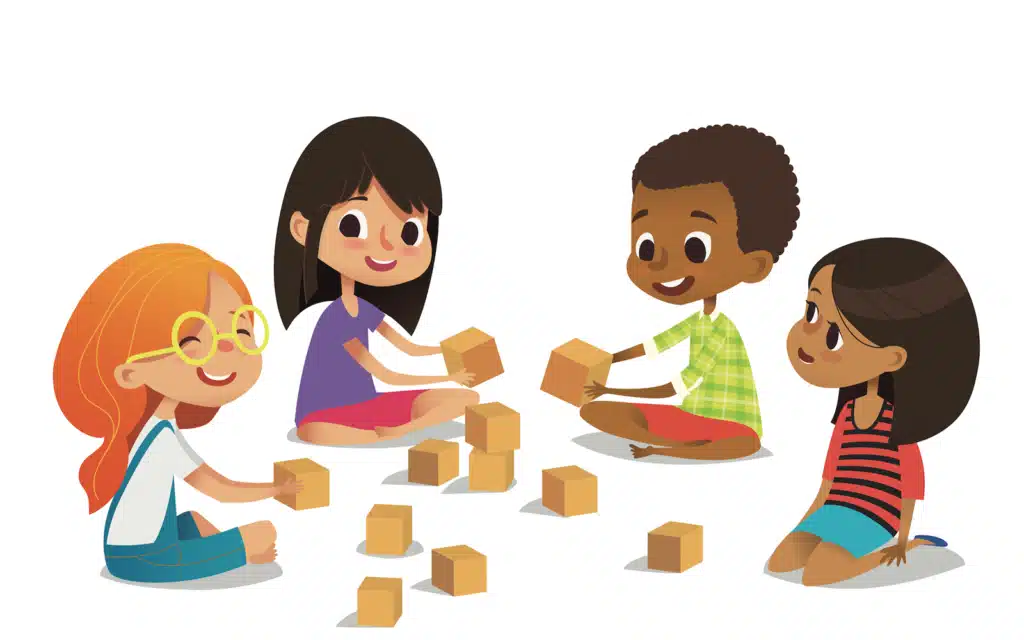
Emotional and Psychological Growth
Building Confidence
Children feel empowered when they are trusted with tasks. The best kitchen learning tower gives them safe access to adult spaces, such as counters and sinks, which helps them feel included and capable. When a toddler uses the folding learning tower to help prepare dinner, it affirms their role in the family or classroom.
Responsibility and Risk Awareness
The best learning tower for toddlers options come with secure side panels and anti-slip features that provide safety without limiting freedom. Children develop an internal understanding of safety and responsibility by navigating a controlled risk environment.
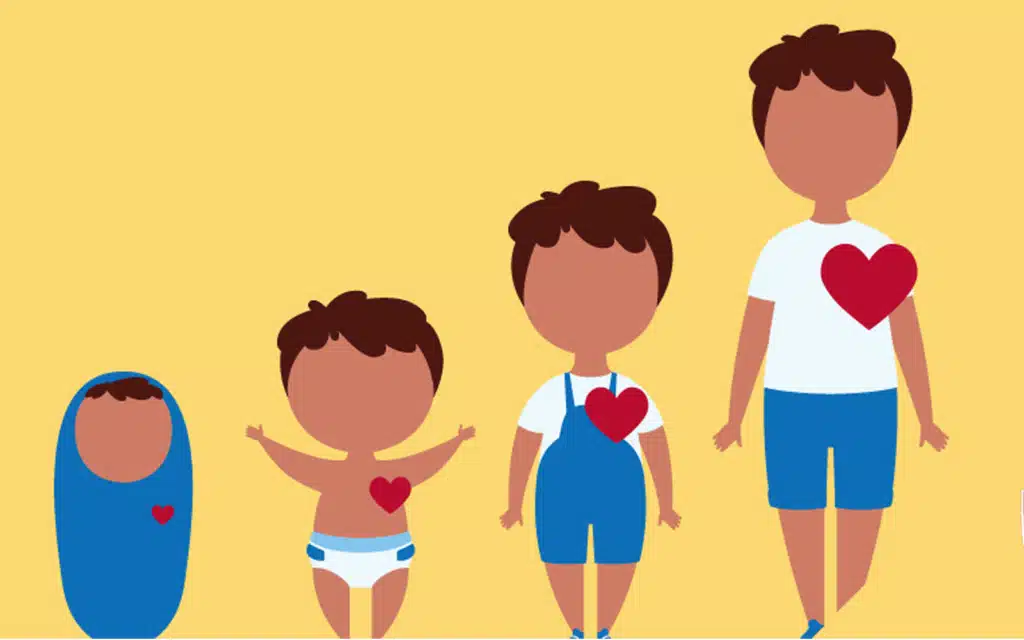
Social and Language Development
Collaboration and Turn-Taking
In both homes and preschools, the toddler tower enables cooperative interaction. Children can participate in group activities at adult height, such as baking or cleaning. They learn to take turns, communicate intentions, and work toward a shared goal—all essential social skills.
Language Development
As children engage in tasks at eye level with parents or teachers, they are exposed to richer conversations and more direct communication. This promotes vocabulary expansion and the ability to express ideas. Narrating a recipe, asking questions about tools, or commenting on smells and textures helps build both expressive and receptive language skills.
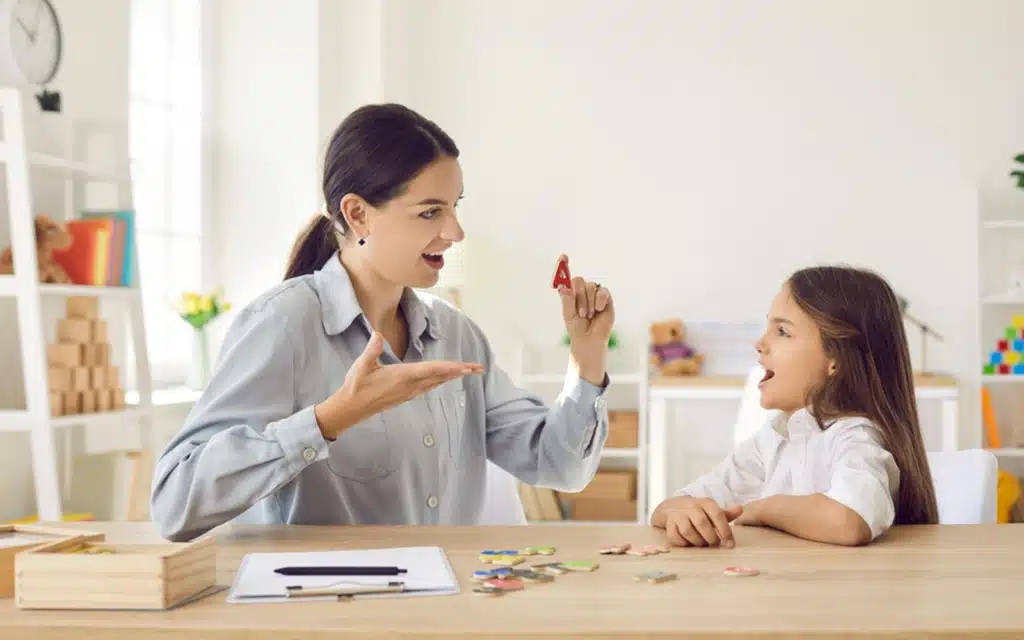
Promoting Independence in a Safe Environment
One of the core principles of Montessori education is “Help me do it myself.” A learning tower is a perfect manifestation of this belief. It offers a child autonomy within clearly defined safety boundaries. The child is not left to climb unsafe chairs or balance on boxes—they are given a structured, intentional space to explore safely and independently.
20 Best Learning Tower Recommend
Choosing the best learning tower can be challenging, especially when balancing safety, price, space, and versatility. Below are 20 highly recommended learning towers for toddlers and preschool use. Each listing includes standout features that support early childhood development while also offering practicality for daily life.
Guidecraft
One of the most widely praised designs, this tower features foldable sides, adjustable platform heights, and safety rails that support toddlers from 18 months to 6 years. It’s built with solid wood and comes with anti-slip feet, making it ideal for both home kitchens and Montessori classrooms. If you’re short on space and want a stable yet storable option, this is the best foldable learning tower for daily use.
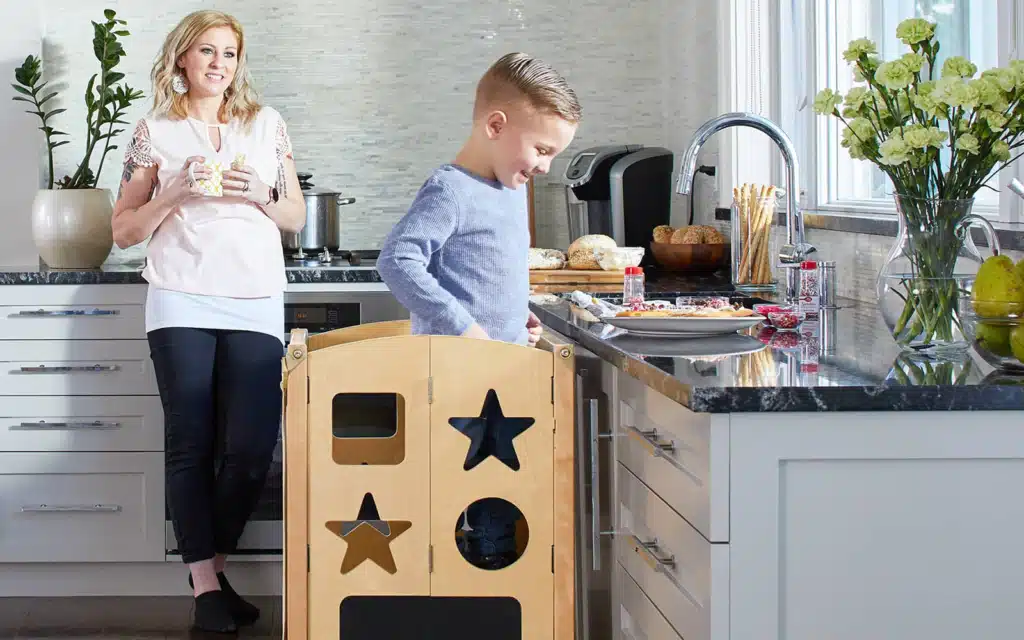
Little Partners
Crafted from durable birchwood and built to last through years of use, this model boasts a wide standing platform and extra height support. Its four-sided design ensures children are enclosed safely while remaining engaged in kitchen or classroom activities. Its height can be adjusted easily, making it the best adjustable learning tower for long-term learning and inclusion.
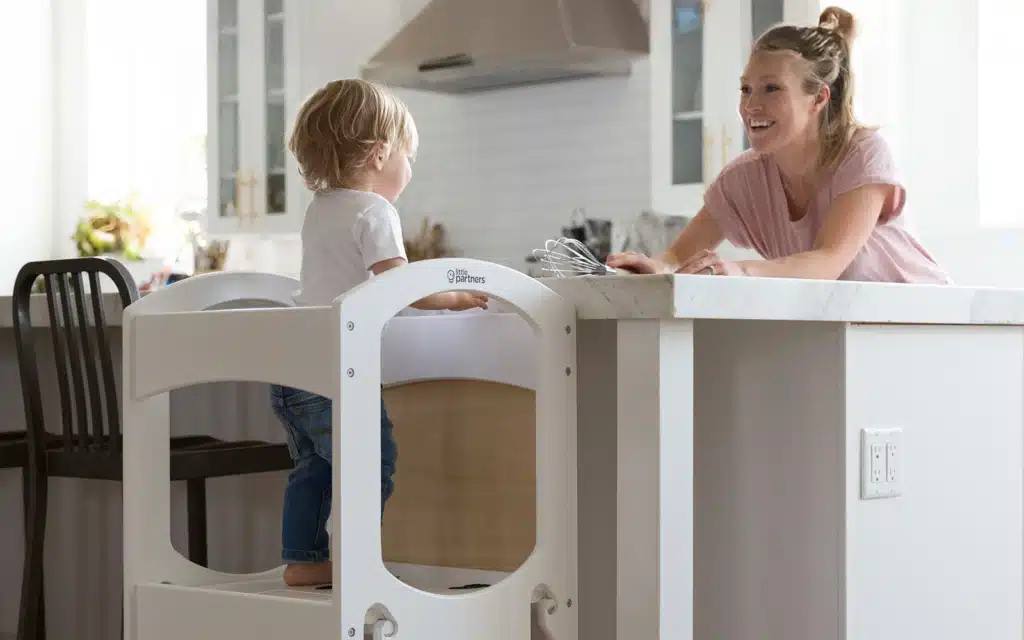
Xiha Montessori
Manufactured by Xiha Montessori, this tower is engineered for commercial kindergarten and preschool use. Built from high-density birch plywood with a smooth, water-resistant finish, it features three adjustable platform heights and an anti-tip design. It’s ideal for children aged 18 months to 6 years, making it one of the best adjustable learning towers.
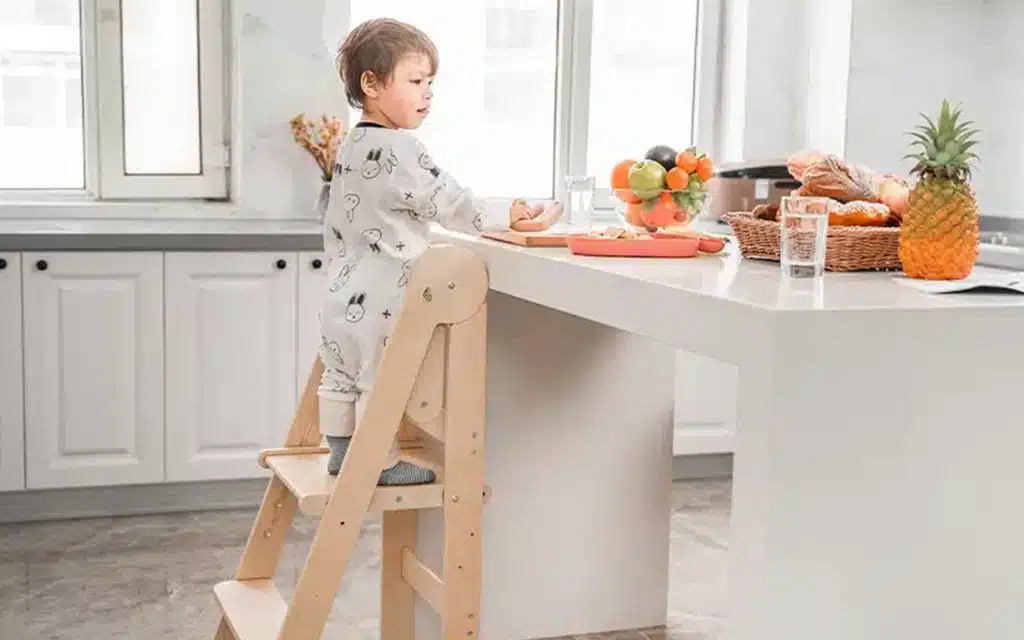
SDADI
Known for its budget-friendly price and solid construction, this tower features pine wood material, three platform levels, and guardrails on all sides. It’s particularly suited for home kitchens, helping toddlers aged 2–5 engage safely in tasks like cooking or handwashing. If you’re looking for the learning tower best price without sacrificing quality, SDADI delivers.

Sprout Kids
Minimalist and stylish, this tower is made from FSC-certified birch plywood and supports tool-free assembly. It’s lightweight yet stable, with a wide base for balance. Designed by Montessori values, it supports independent activity for children as young as 18 months. It’s one of the best wooden learning tower options for Montessori homes or Reggio-inspired schools.
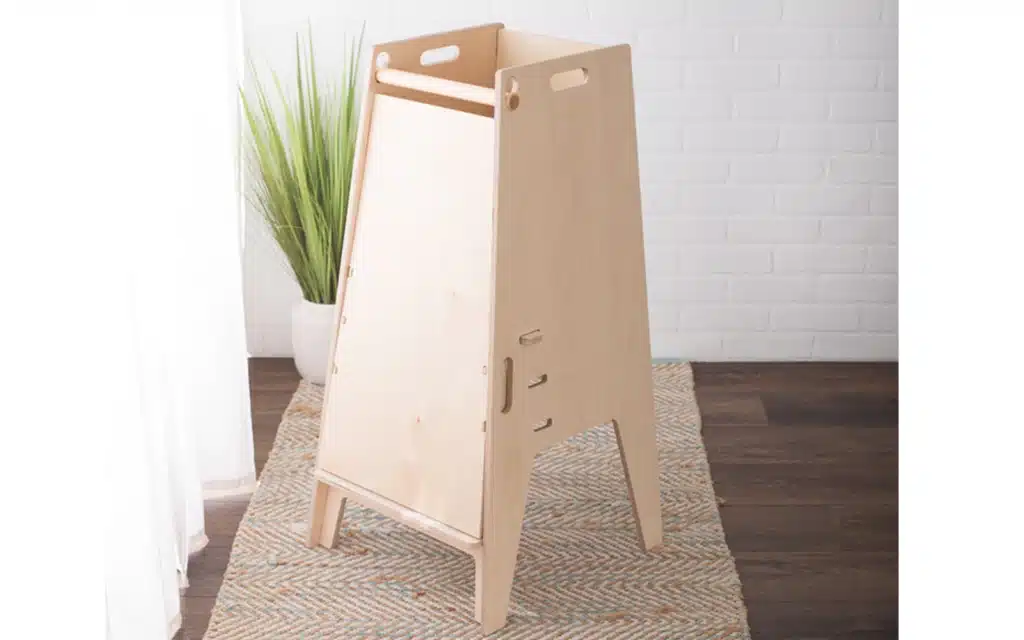
Xiha kidz
From early learning brand Xihakidz, this multifunctional model transforms from a toddler tower into a desk and chalkboard. Built with eco-friendly MDF and rounded edges for extra safety, it’s ideal for kids between 2 and 6 years old. Schools love its versatility: during activity time, it’s a drawing desk, and during snack prep, it becomes the best kitchen helper learning tower. If you’re sourcing multifunctional, space-saving furniture, this is a strong best convertible learning tower pick.
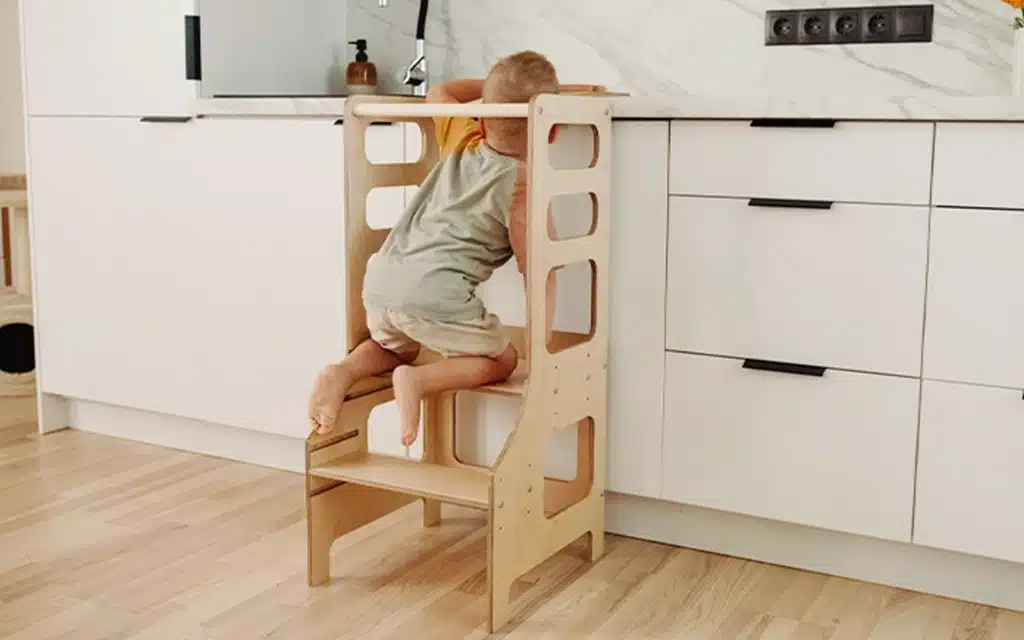
Wood City
Crafted from natural pine wood and finished with child-safe paint, the Wood City Toddler Tower is a practical, no-frills solution for everyday household use. The design includes two step-in entry points, rounded safety bars, and a wide platform for toddlers to move comfortably. Perfect for homes, Montessori micro-schools, or small-scale educational centers seeking basic, safe participation tools.
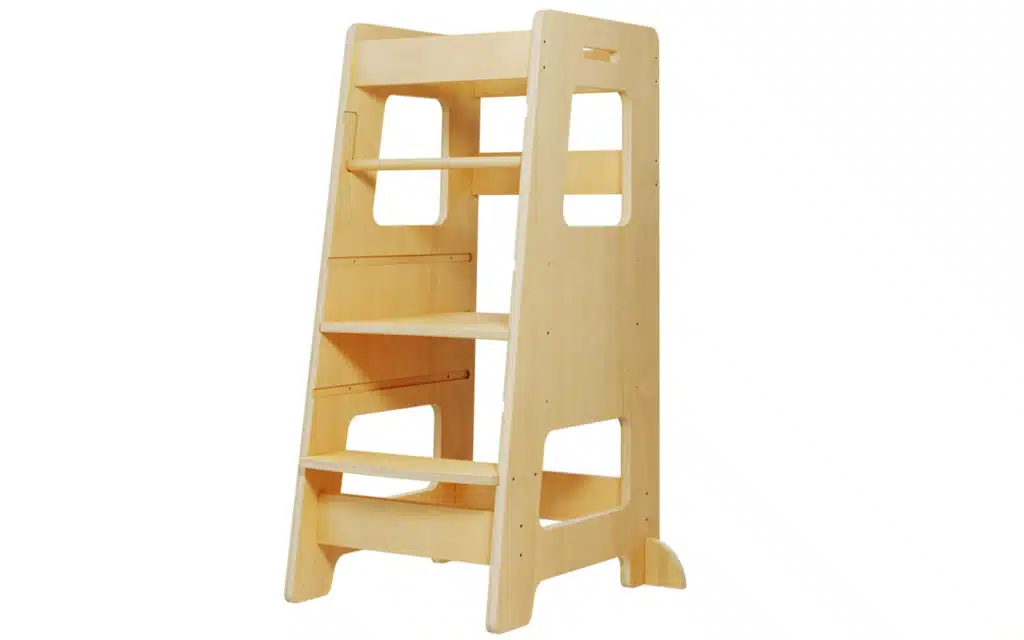
Simplay3
This plastic tower is durable, lightweight, and easy to wipe clean—great for indoor and outdoor use. Designed for children between 18 months and 4 years, it features two climbing steps and a wide top platform. It’s especially suitable as a best baby learning tower for first-time toddler climbers and busy parents.
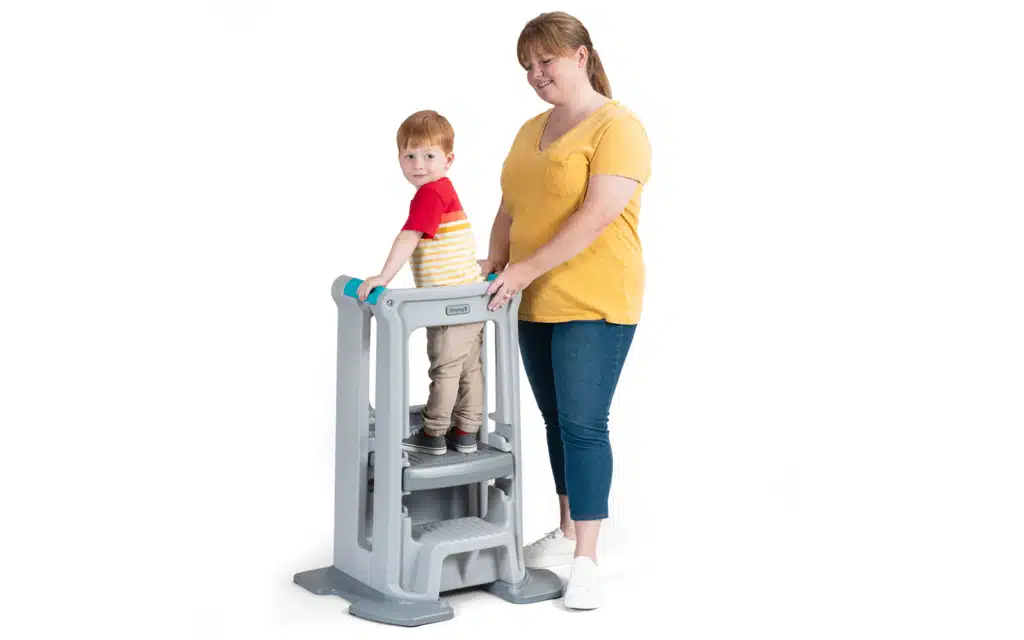
Xiair world
Xiairworld brings innovation to foldable designs with this lightweight yet sturdy kitchen helper. Crafted from sustainable wood, it folds flat within seconds for easy storage and transport—perfect for daycares or compact kitchens. It includes safety railings, non-toxic paint, and reinforced base legs. This tower is best suited for children aged 1–4, earning its place as a foldable toddler learning tower.

ECR4Kids
ECR4Kids delivers a preschool-grade product with easy folding, locking safety latches, and rounded edges. It suits environments where multiple children need supervised access to kitchen counters or sink areas. With a non-slip platform and water-resistant finish, this is a smart choice for kitchen learning towers for institutions.
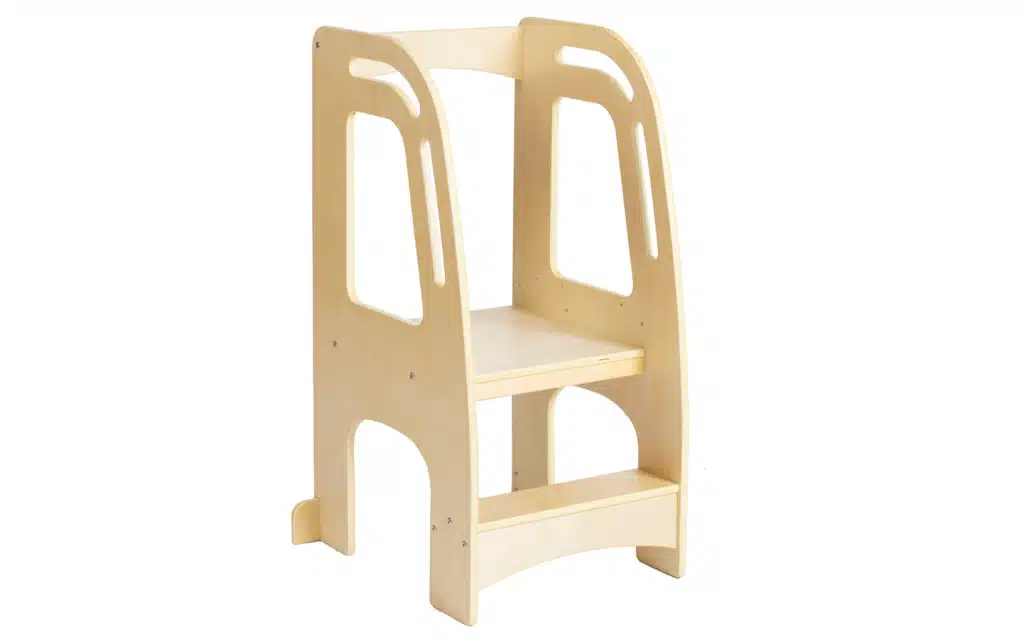
Monti Kids
Developed by early childhood education experts, the Monti Kids Convertible Learning Tower is a multi-purpose powerhouse. It transforms seamlessly from a secure standing platform into a chalkboard desk or art station. Families who homeschool or run small childcare programs will find it especially valuable for transitioning between different activities throughout the day.
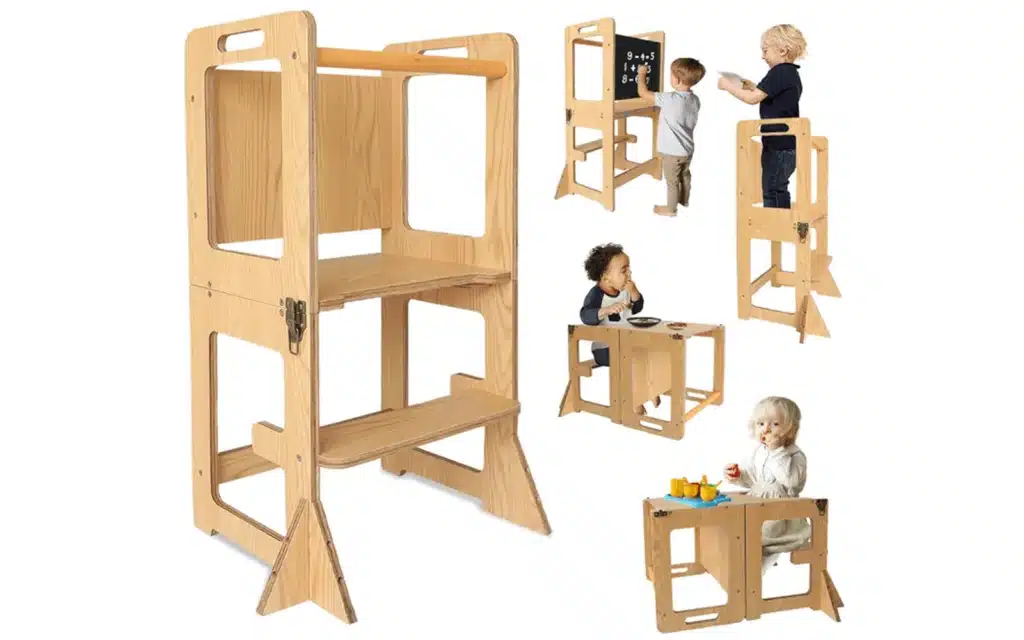
Milliard
Simplicity and safety meet in the Milliard Wooden Folding Tower, a compact, foldable model built from solid wood with child-safe lacquer. Designed for children 18 months to 5 years, it features a safety bar, sturdy platform, and low step for easy entry. The tower folds neatly into a flat profile for easy storage, which makes it an ideal best folding learning tower for families who want function without bulk. The structure is strong enough for daily use and light enough to move around the house.
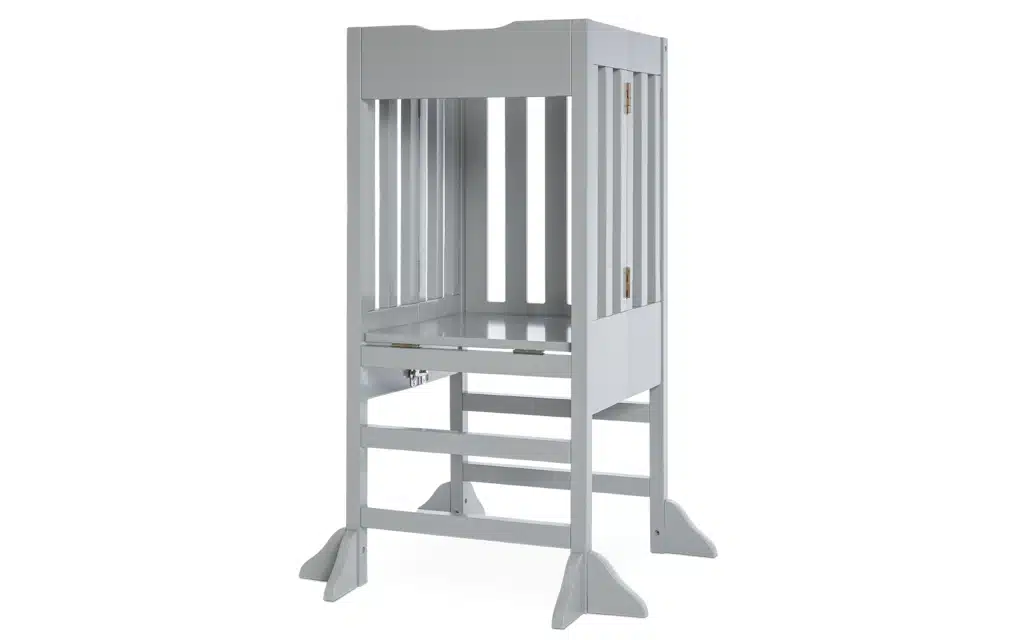
Xihatoy
Xihatoy offers one of the most engaging and versatile towers in this lineup, combining functionality with creativity. This solid pine wood tower is finished with smooth, child-safe varnish and features a built-in chalkboard panel—perfect for adding drawing and writing activities to a child’s daily routine. The platform adjusts to two different heights, making it suitable for kids aged 18 months to 5 years. Designed with four enclosed sides for maximum safety, the unit gives toddlers the freedom to explore elevated spaces without risk.
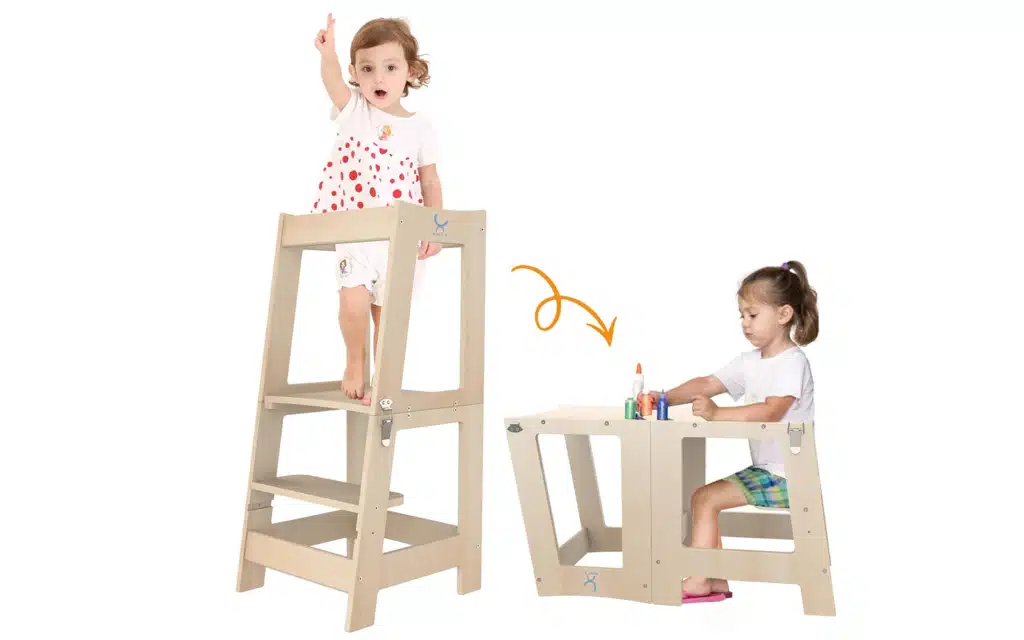
Picclio
The Picclio Learning Tower is a beautifully crafted piece of functional furniture that offers both elegance and safety for toddlers learning to engage in daily routines. Made from durable hardwood with a natural finish, it features three adjustable platform heights to accommodate children from 18 months to 6 years. The enclosed four-sided frame ensures maximum stability and protection, while the smooth, rounded edges reduce the risk of bumps and bruises during active use.
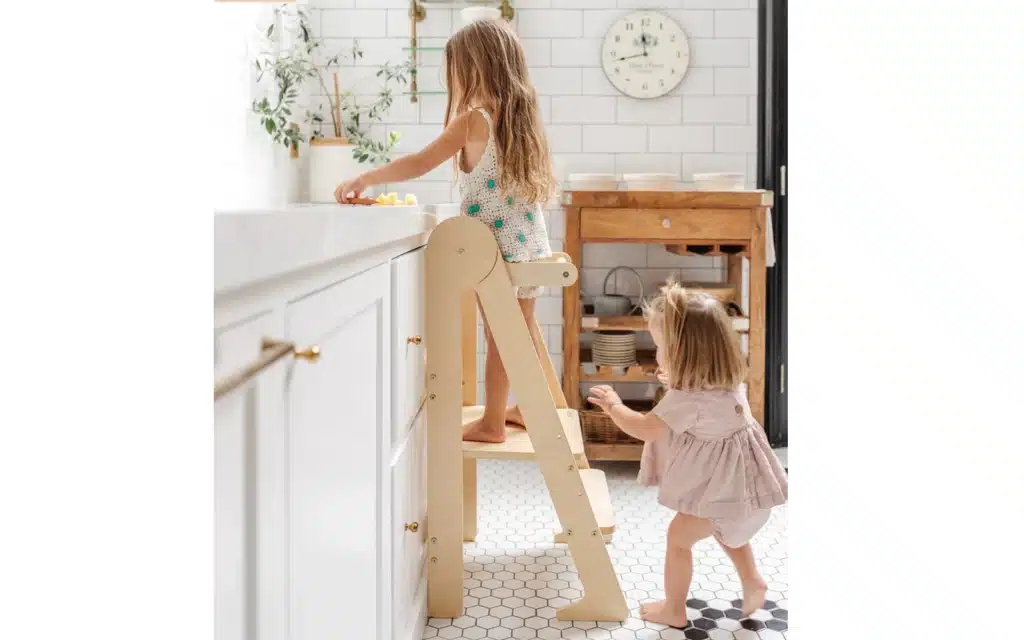
CASSARO KIDS
Eco-conscious and stylish, the CASSARO Bamboo Montessori Tower is crafted from 100% sustainably harvested bamboo. Designed for children aged 18 months to 5 years, this model emphasizes environmental responsibility without compromising function. It features three adjustable height levels, non-slip feet, and a unique locking system that ensures stability. Because bamboo is naturally water-resistant and antimicrobial, this tower performs well in both kitchens and bathrooms.
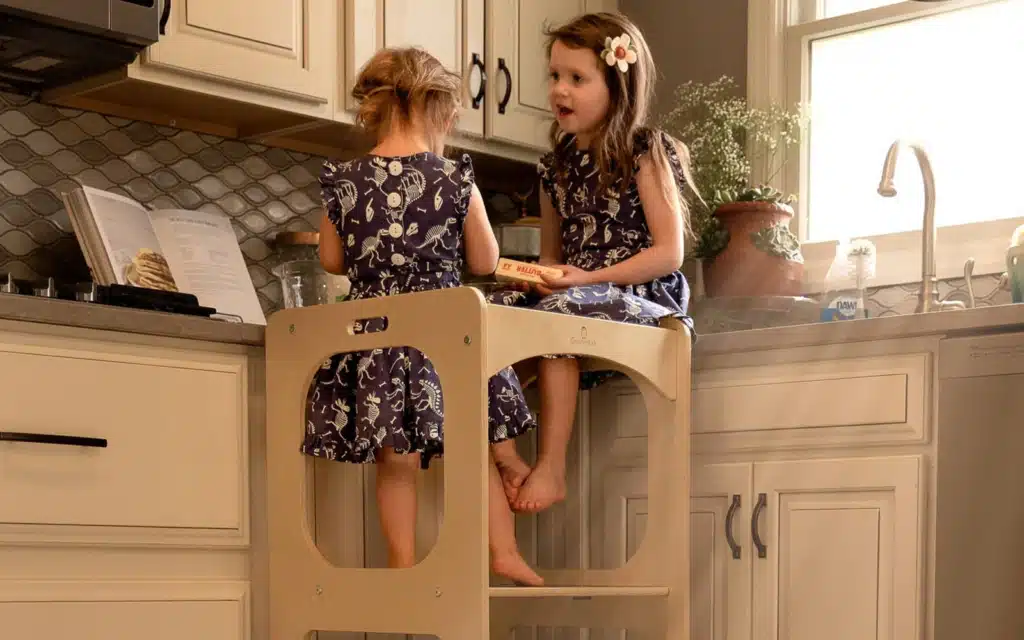
UNICOO
Combining creativity with core functionality, the UNICO Wooden Chalkboard Learning Tower features a convertible blackboard panel on its side, inviting kids to draw or write as they engage in real-life tasks. Built with solid pine and finished with child-safe paint, this tower supports toddlers from 18 months to 5 years. It includes a stable step-in base, side rails for safety, and a wide standing platform. This is one of the best learning tower 2-year-old options that blends imagination with practical life learning.
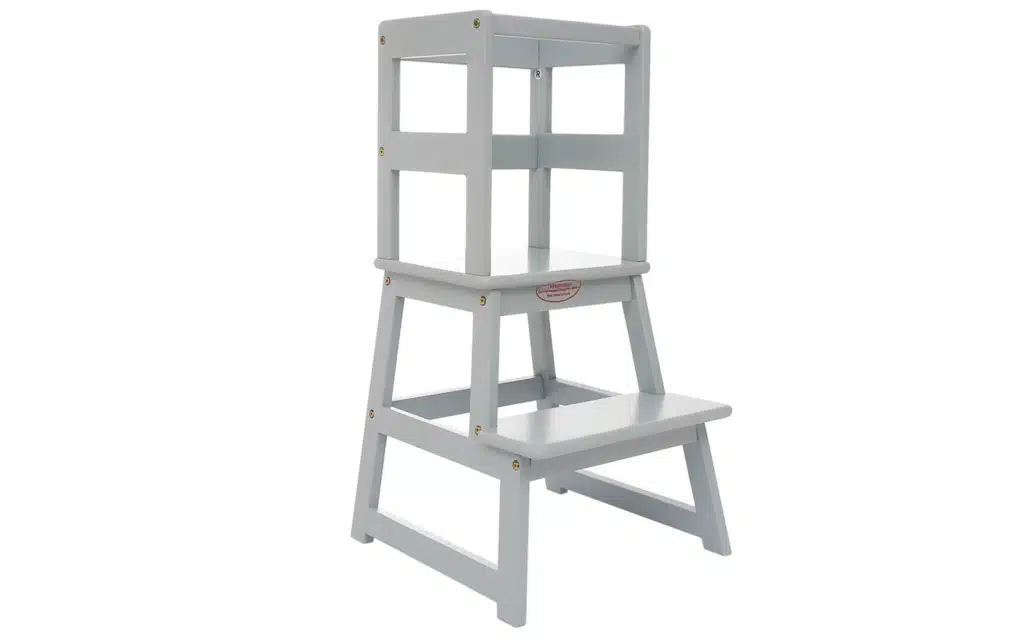
KidzWerks
The KidzWerks Standing Tower is a classic, Montessori-inspired model built to encourage independent participation in daily routines. Constructed from high-grade birch plywood, this tower has an adjustable platform and a sleek finish that fits modern homes and classrooms alike. It is ideal for children aged 2 to 6, offering enough space and security to engage in activities such as food prep, painting, or teeth brushing. KidzWerks also provides an optional whiteboard surface or activity panel add-on, transforming the tower into a dual-purpose play station.
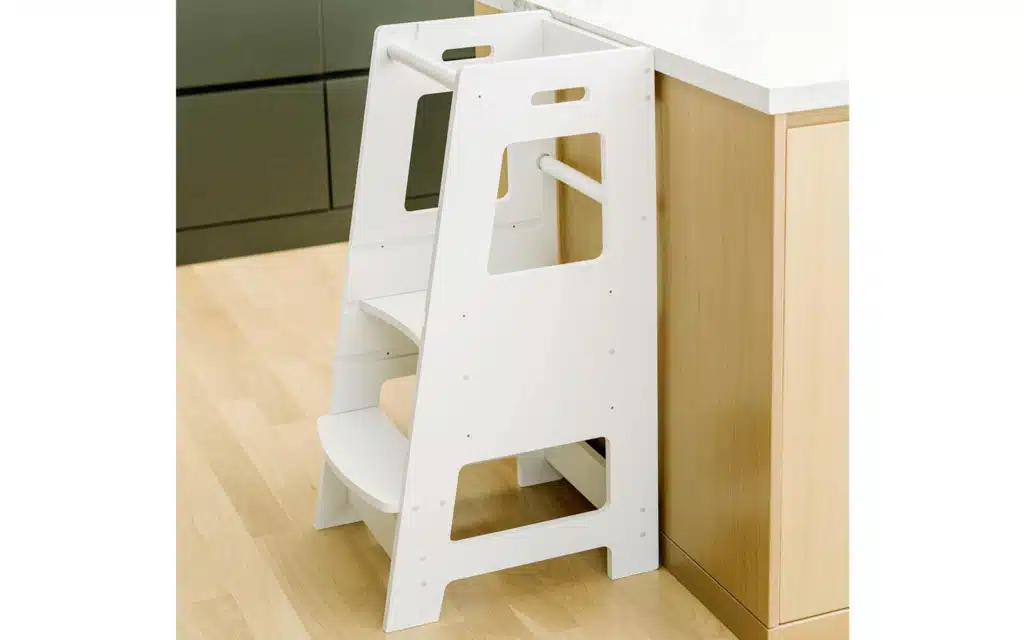
OCODILE
The OCODILE Learning Tower is a versatile and thoughtfully designed product that’s gaining popularity among modern families for its practical features and sturdy craftsmanship. Constructed from solid natural wood, this tower includes three adjustable platform heights, allowing it to grow with your child from 18 months to over 5 years. Its sleek lines, smooth edges, and enclosed frame make it exceptionally safe and comfortable for toddlers who are new to standing at countertop level. This unit is perfect for use in kitchens, bathrooms, or classrooms—wherever young children are invited to participate.
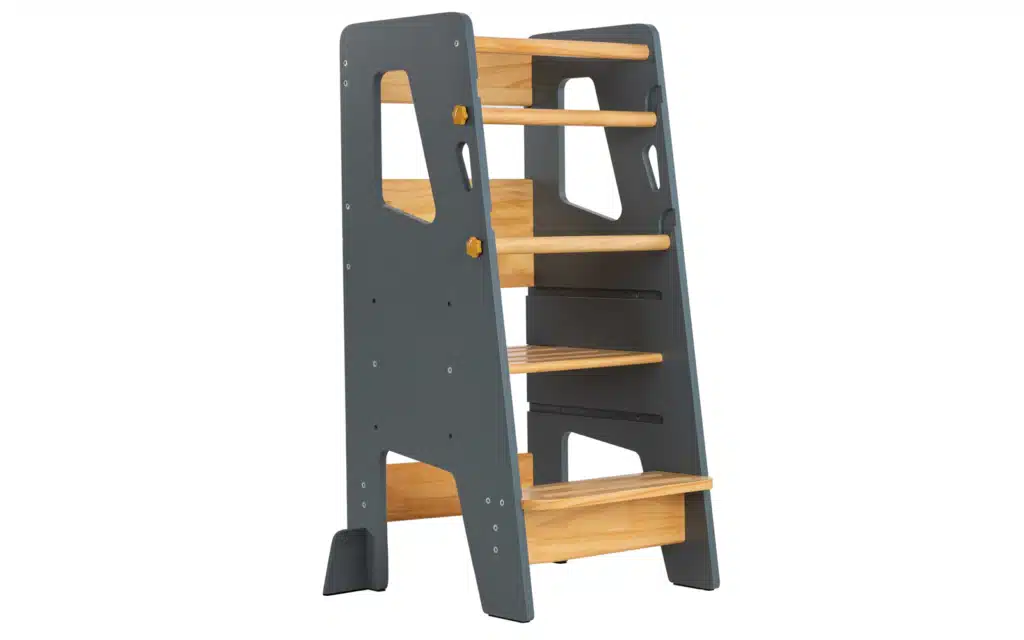
COSYLAND
The COSYLAND Foldable Kitchen Helper is a stylish, space-saving solution for families who prioritize both safety and convenience. Made from high-quality MDF and coated with non-toxic finishes, this tower offers a stable, enclosed standing platform for children aged 1 to 5. Parents love the soft edges, ergonomic handles, and easy-to-clean surfaces. Its neutral color palette blends into any home decor, while its lightweight frame allows quick movement from kitchen to bathroom or playroom.
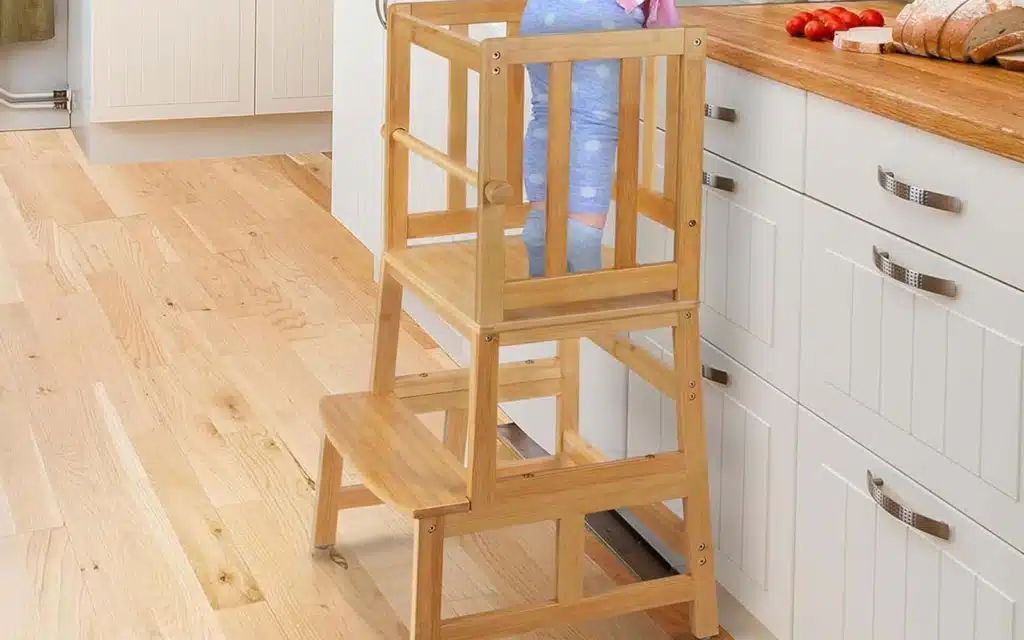
Woodure
The Woodure Montessori Learning Tower is built for parents and educators who value craftsmanship, safety, and educational alignment with Montessori principles. Made from premium-grade beech or birch hardwood, this tower combines natural aesthetics with lasting durability. It features three adjustable platform levels, anti-slip feet, and four enclosed sides to ensure children stay secure while participating in daily tasks. Recommended for children aged 18 months to 6 years, it encourages independence and confidence in toddlers as they cook, clean, or explore sensory activities at adult height.
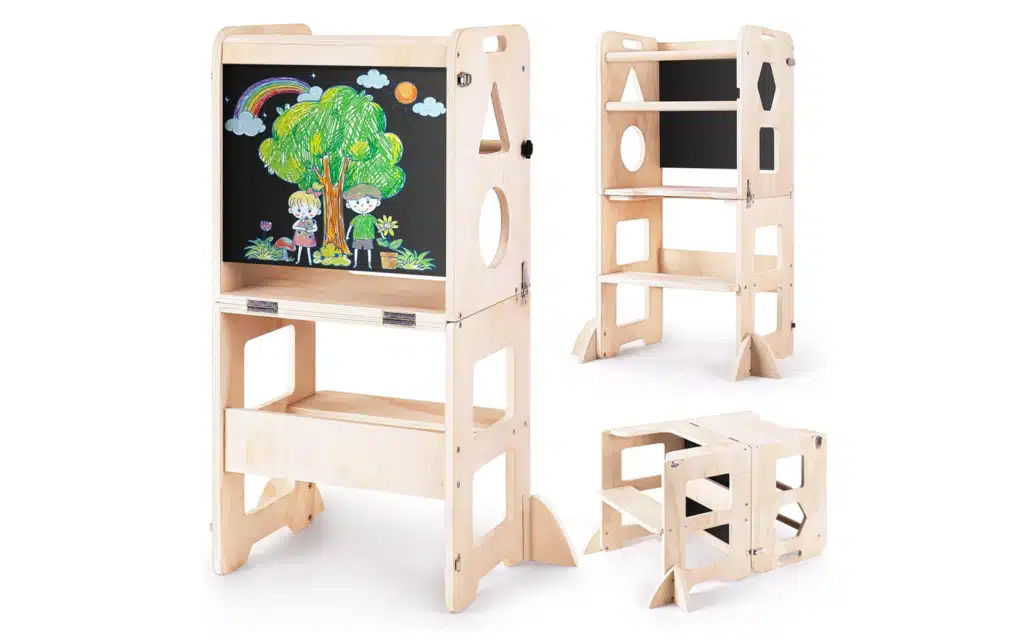
Age-Specific Activities with Learning Towers
| Age Range | Developmental Focus | Recommended Activities | Learning Tower Features to Prioritize |
|---|---|---|---|
| 12–18 months | Standing stability, sensory exploration | – Hand washing at sink – Watching meal prep – Touching soft kitchen items | – Low platform height – Full safety enclosure – Anti-slip base |
| 18–24 months | Gross motor skills, imitation learning | – Stirring ingredients – Placing items on a tray – Brushing teeth | – Wide base – Adjustable platform – Rounded edges |
| 2–3 years | Independence, fine motor control | – Cutting bananas with toddler knife – Pouring water – Wiping counters | – Mid-height platform – Durable wood – Stable hand grips |
| 3–4 years | Problem-solving, sequencing tasks | – Making sandwiches – Organizing utensils – Sorting fruits & veggies | – Chalkboard add-on – Extra workspace – Higher weight capacity |
| 4–6 years | Social learning, multitasking | – Helping cook meals – Reading recipes aloud – Washing dishes | – Convertible function (tower to desk) – Space for 2 kids – Foldable design |
Safety First: The Key When Toddlers Use a Learning Tower
In modern Montessori classrooms, preschools, and family homes, the learning tower has become a staple of early childhood development. These towers allow toddlers to safely stand at adult height and participate in real-life activities like cooking, cleaning, and organizing. But behind the benefits lies a critical consideration: safety. No matter how well-designed a tower may be, without the right precautions, accidents can still happen.
Even the best learning tower will only be effective if it’s used safely and correctly. Whether you’re a parent purchasing for home use or a school director outfitting a classroom, understanding the safety fundamentals is essential.
Why Safety Is Critical in Learning Tower Use?
Toddlers are naturally curious and eager to explore their surroundings. That’s exactly what makes learning towers so valuable—they give children a way to participate in adult life at eye level. However, toddlers are also still developing balance, coordination, and decision-making skills. Without protective design features or close supervision, they may fall, reach for hazardous items, or misuse the tower altogether.
Learning towers raise children off the ground—sometimes by as much as 50 cm or more. A minor slip or incorrect movement can easily lead to injury. Prioritizing safety isn’t optional. It’s the foundation on which all the benefits of a learning tower are built.
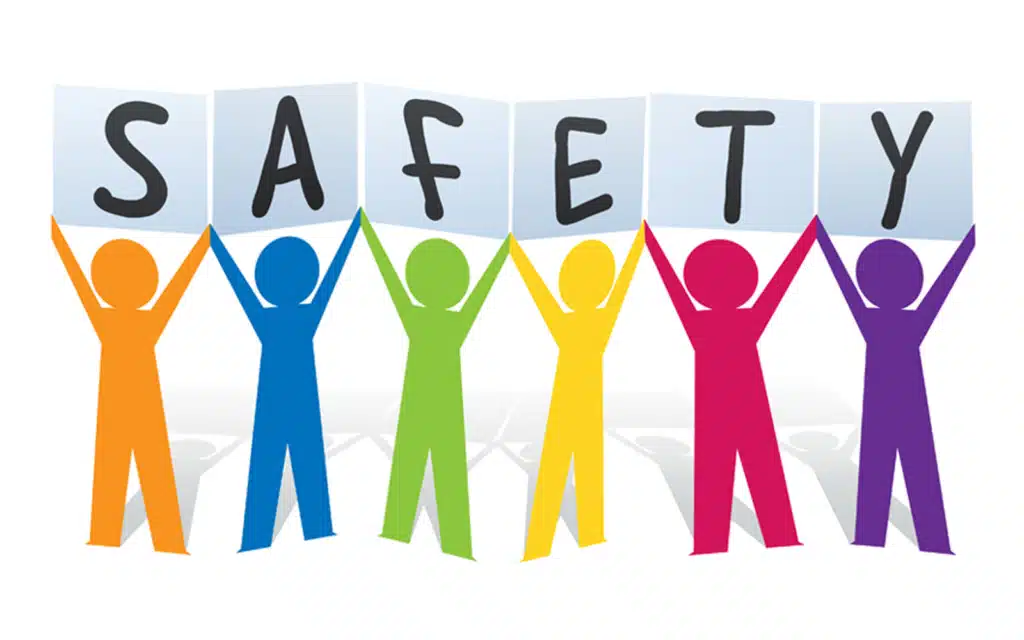
Key Features of a Safe Learning Tower
Several essential design elements work together to ensure the child remains protected while using the toddler tower. Enclosed sides are the most critical feature. The safest towers have at least three, preferably four, surrounding sides with guardrails. These barriers prevent children from falling sideways or backward.
A wide, stable base reduces the likelihood of tipping. Towers should sit evenly on the floor and resist rocking or shifting when the child moves. Adjustable platform height ensures that toddlers of different ages and sizes can stand at a level that’s appropriate for their stage of development. This helps keep their center of gravity low, reducing fall risk.
Non-slip footing, both underneath the tower and on the platform itself, prevents sliding on smooth surfaces and helps the child maintain grip while standing. Materials should be non-toxic and child-safe. Smooth wooden edges, food-grade finishes, and sealed joints reduce exposure to splinters, chemical residues, and sharp surfaces.
Best Practices for Safe Setup and Daily Use
Buying the best learning tower is only the first step. Equally important is how it’s used daily. The tower should always be placed on flat, even ground—never on carpet, mats, or uneven surfaces. Avoid high-risk areas like near stovetops, ovens, or countertops holding sharp or hot objects. Ideal locations include kitchen counters (away from heat), bathroom sinks, or child-accessible tables.
Supervision is essential. A toddler should never use the learning tower without an adult within arm’s reach. Even older children can misstep or get distracted. Remember, the learning tower is a tool for guided independence, not unsupervised play. Keep the surrounding space tidy and hazard-free. Spilled water, cooking oil, or scattered objects can quickly turn into safety risks. Remove nearby knives, small choking hazards, and any cords or appliances within the child’s reach.
If the tower is foldable, always lock it into place before use. An unlocked frame can collapse unexpectedly, even under a child’s light weight. Perform regular checks to make sure all screws are tight, the platform is secure, and no cracks or structural damage have developed over time.
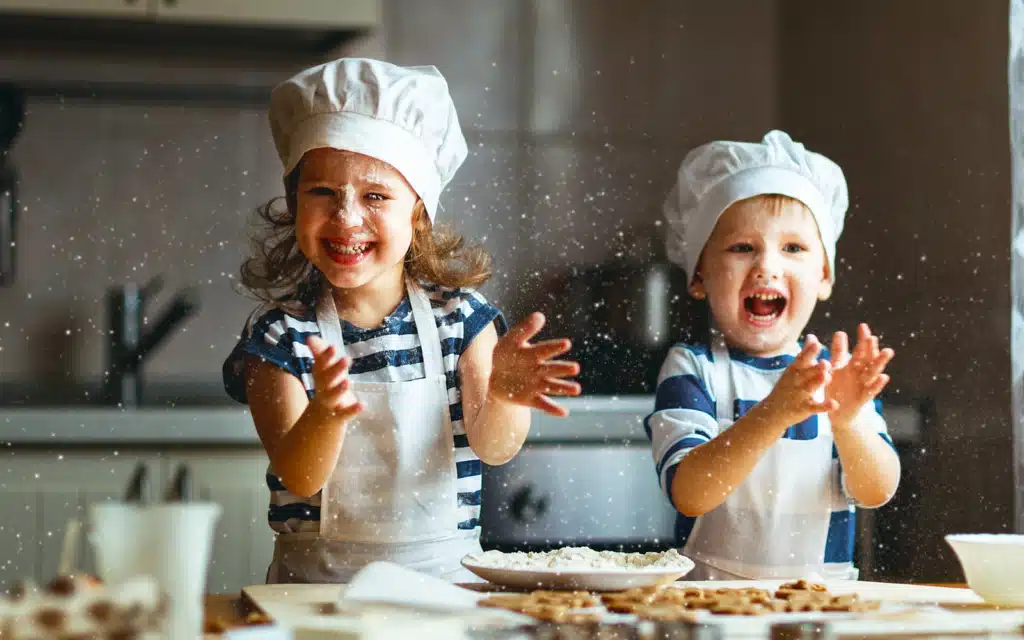
Age-Appropriate Use Guidelines
While most learning towers are marketed for children between 18 months and 6 years, not every model is suitable for every age group. The best learning tower should support developmental stages with safety, adjustability, and comfort.
At 12–18 months, toddlers need maximum enclosure and lower platform heights. The tower must offer deep side panels and non-slip surfaces, allowing safe exploration with full adult supervision. At this stage, climbing ability is limited, so ease of entry is less important than full containment.
From 18–36 months, children begin to climb independently. The best learning tower for 2-year-olds should have stable side access and an adjustable standing level that grows with the child. Between 3–6 years, children engage in more complex tasks like washing dishes or preparing snacks.
They need towers that provide enough space to move safely without sacrificing balance. A truly best learning tower design will accommodate all these changes without compromising security or structure.
Common Mistakes to Avoid
Many parents and educators purchase high-quality products but fail to use them correctly. One of the most common mistakes is assuming that owning the best learning tower eliminates the need for supervision.
In reality, even the safest tower becomes dangerous when used without clear rules and adult guidance. Another mistake is poor placement. Towers should never be positioned near stovetops, sharp knives, hot pans, or unstable countertops. Even the best folding learning tower must be used in a hazard-free zone.
Allowing children to treat the tower as a toy—climbing on the outside, jumping off, or dragging it around the house—is another frequent issue. These behaviors undermine the tool’s safety purpose and create unnecessary risks. Lastly, many users forget to check the structure over time. Loose screws, worn anti-slip pads, or cracks in the platform can turn the best learning tower into a safety hazard. Regular inspection is not optional—it’s part of responsible tower ownership.
Building Safe Habits Through Supervised Use
The best learning tower doesn’t just support physical access to adult-height surfaces—it supports developmental lessons in responsibility and safety. From the first day of use, toddlers should be introduced to the tower as a tool, not a toy. Adults must model safe behaviors like climbing in slowly, holding both sides, and staying within the boundaries.
Use consistent cues such as “two feet,” “hold the rail,” or “no jumping.” When paired with verbal guidance, these rituals create lasting behavioral habits. A major benefit of using the best toddler learning tower is that it can help children internalize safe, respectful routines around real-world tasks. Whether helping to wash vegetables or set the table, toddlers learn that independence comes with responsibility.
Supervision should always be present, not just for protection, but for instruction. When the best learning tower is used as part of a guided learning experience, it becomes a bridge to safer, more confident, self-directed activity.
FAQs
1. What is the best learning tower for a 2-year-old toddler?
The best learning tower for a 2-year-old should feature a wide, stable base, easy side access, and adjustable platform height. At this age, toddlers are developing independence and will begin climbing in and out of themselves. A safe design with full enclosure and non-slip footing supports their growth while minimizing risk.
2. Can I use a learning tower for children under 18 months?
While some towers are marketed for 12 months and up, using a learning tower under 18 months requires extreme caution. The best learning tower for this age group should include deep side panels, a very low platform, and be used only with direct supervision. It’s critical to assess your child’s standing and balance ability first.
3. How do I make sure my learning tower is safe to use every day?
To keep your tower safe, inspect it weekly for loose screws, worn grips, and structural cracks. Even the best learning tower can become unsafe if neglected. Make sure the base is level, the platform is secure, and it’s placed in a hazard-free zone. Regular cleaning and checking are essential parts of tower maintenance.
4. Is it safe to let toddlers use the learning tower without supervision?
No. Regardless of how secure or enclosed the design is, the best toddler learning tower must be used under adult supervision. Toddlers may attempt to misuse the tower—climbing outside of it, jumping, or dragging it toward unsafe areas. Adults should always be nearby to guide and prevent accidents.
5. What are the biggest mistakes people make with learning towers?
Common mistakes include placing the tower too close to hot surfaces, letting children use it unsupervised, and using it on uneven or slippery flooring. Another error is treating it as a toy instead of a structured tool. The best learning tower must be used intentionally, with clear rules and regular adult engagement.
6. How do I teach my child to use the learning tower safely?
Start by modeling the correct way to climb in and out, hold the rails, and remain inside the structure. Use simple verbal cues like “hold on” or “feet first.” When used consistently, these practices help children treat even the best learning tower with focus and care, building safe habits over time.
7. Can one learning tower be used for multiple age groups?
Yes, especially if you choose the best adjustable learning tower. Models with adjustable platform heights can safely support children from 18 months to 6 years. Look for designs that adapt to the child’s stage, ensuring they remain secure and engaged as they grow in height and ability.
Conclusion
A learning tower is more than a piece of furniture—it’s a developmental tool that gives toddlers the opportunity to safely engage in the adult world. However, to unlock its full potential, safety must come first. Choosing the best learning tower means looking beyond design and price. It involves understanding your child’s stage of development, setting up the tower in a secure environment, and using it with consistent supervision. From ensuring proper placement to teaching respectful habits, every detail contributes to a safe and enriching experience. Whether you’re guiding a curious 2-year-old or supporting a preschooler’s independence, the learning tower should adapt to your child’s needs, not the other way around. Adjustable height, enclosed sides, and non-slip surfaces are essential, but so is your presence and attention. When used responsibly, the best learning tower can be a daily tool for growth, confidence, and connection between child and caregiver.

